Lewin Benjamin (ed.) Genes IX
Подождите немного. Документ загружается.

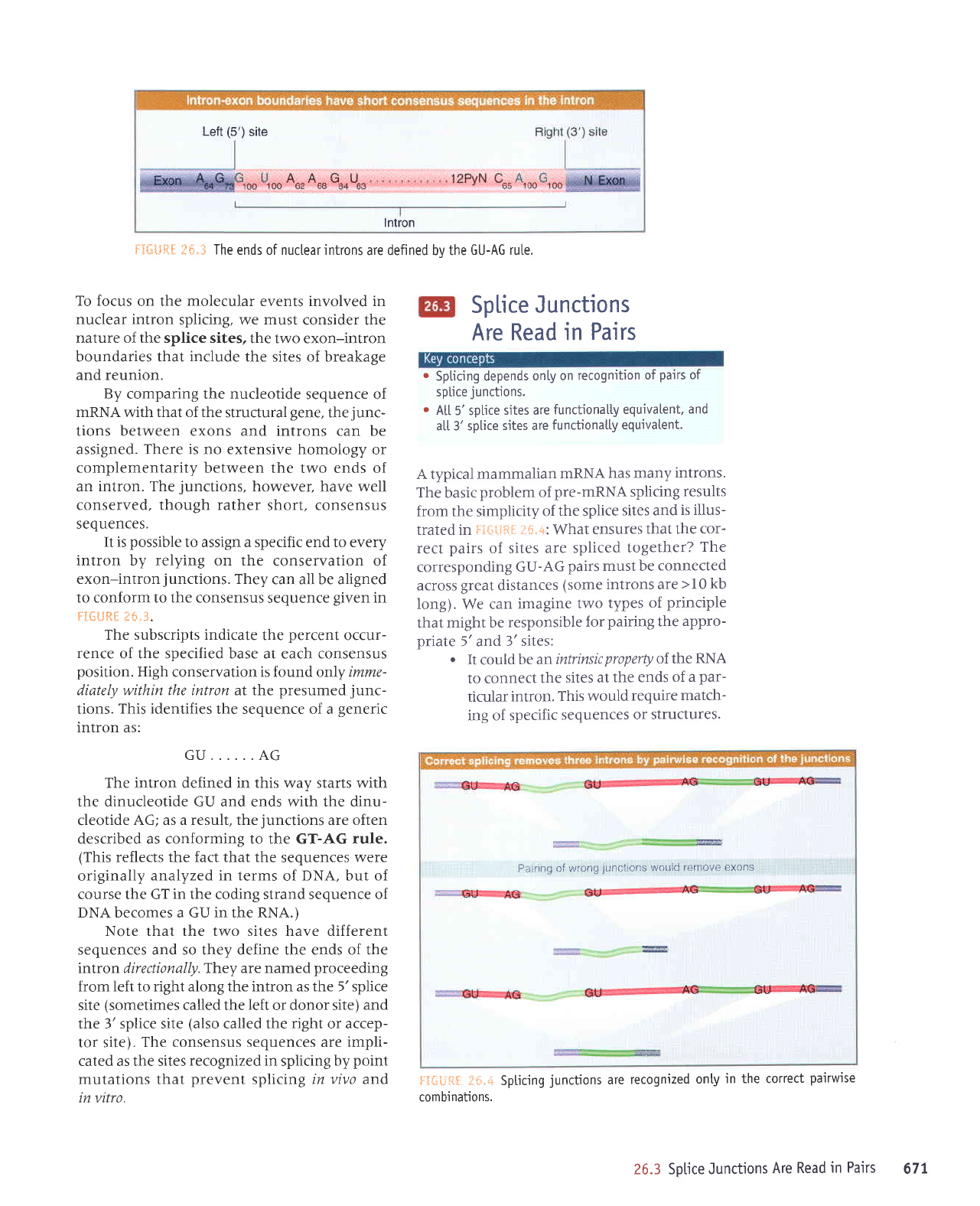
Left
(5')
site
lntron
i:SlJg{[ f$"] The
ends of nuclear introns
are defined bv the
GU-AG rul.e.
To focus
on the
molecular
events involved in
nuclear intron
splicing, we must
consider the
nature of the splice sites,
the two exon-intron
boundaries that
include
the sites of breakase
and reunion.
By comparing the nucleotide
sequence of
nRNA with that of the
structural
gene,
the
junc-
tions between exons and introns can be
assigned. There is no extensive homology
or
complementarity between
the two ends of
an
intron. The
junctions,
however, have well
conserved, though rather
short, consensus
sequences.
It is
possible
to assign a specific end to every
intron by relying on the
conservation of
exon-intron
junctions.
They
can all be aligned
to conform to the consensus
sequence
given
in
rI**Rf f$.:.
The subscripts indicate
the
percent
occur-
rence
of the specified base at each consensus
position.
High
conservation is found only imme-
diately within the intron at the
presumed
junc-
tions.
This identifies
the sequence of a
generic
intron as:
GU......AG
The intron defined in this way starts with
the dinucleotide GU and ends with the dinu-
cleotide
AG; as a result, the
junctions
are often
described as conforming to the GT-AG rule.
(This
reflects the fact that the
sequences
were
originally
analyzed in terms
of
DNA,
but
of
course the GT
in
the coding strand sequence of
DNA becomes a GU in the RNA.)
Note
that the two sites have different
sequences and so they define the ends of the
intron directionally. They are named
proceeding
from left to right along the intron as the 5'splice
site
(sometimes
called the
left
or donor site)
and
the 3' splice site
(also
called the
right
or accep-
tor site).
The consensus sequences are impli-
cated as the sites
recognized in
splicing
by
point
mutations that
prevent
splicing in
vivo
and
in
vitro.
SpLice
Junctions
Are Read
in
Pairs
.
Spticing depends
onty on
recognition
of
pairs
of
sptice
junctions.
.
A[[
5'splice
sites are
functiona[[y
equivalent,
and
at[ 3' spl.ice
sjtes are
functionatly
equivalent.
A typical mammalian
nRNA
has many
introns.
The
basic
problem of
pre-nRNA
splicing
results
from the simplicity
of the
splice
sites and
is illus-
trated in
Ft+|iftf;.
:lfi.'i:
What
ensures
that the
cor-
rect
pairs
of sites
are spliced
together?
The
corresponding
GU-AG
pairs
must be
connected
across
great
distances
(some introns are
>10
kb
long). We can
imagine
two
types
of
principle
that
might be
responsible
for
pairing
the
appro-
priate
5'and
3'sites:
.
Itcouldbe
anintrinsicproperf
of theRNA
to connect
the
sites at
the ends
of a
par-
ticular intron.
This
would
require
match-
ing of specific
sequences
or structures.
Pairing
of wrong
juncttons r
totilcl
renrove exons
fI*$frf t{i.+ SpLicing
junctions
are
recognized
onty
in the correct
pairwise
combinations.
26.3 Sptice Junctions
Are
Read
in Pairs 677
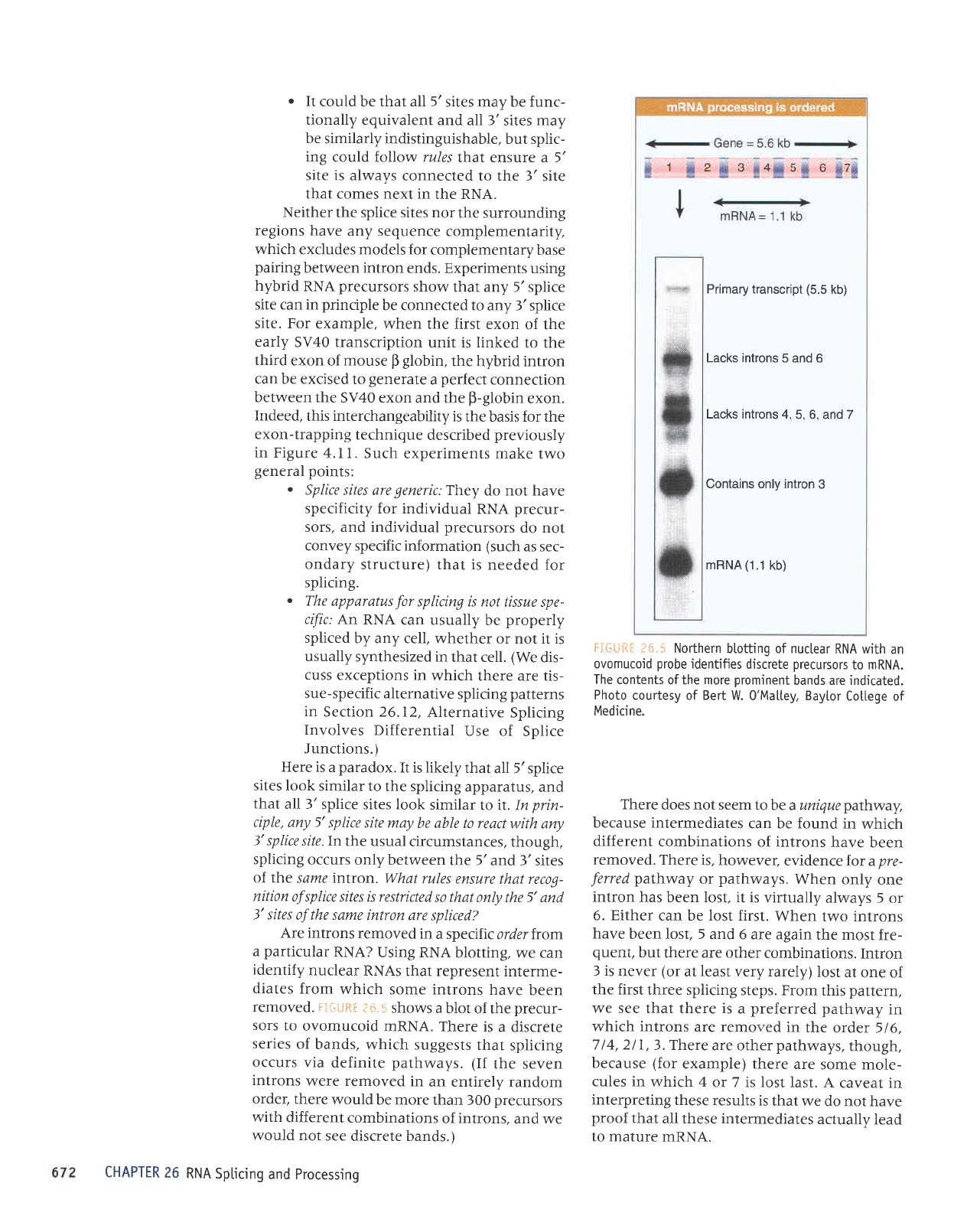
.
It
could be that all 5'sites
may be func-
tionally
equivalent and all 3'
sites
may
be
similarly indistinguishable,
but splic-
ing
could follow rules
that ensure a 5'
site is always
connected to the 3'site
that comes next
in the RNA.
Neither
the splice sites nor
the surrounding
regions
have any sequence
complementarity,
which
excludes models
for complementary
base
pairing
between intron
ends. Experiments
using
hybrid
RNA
precursors
show
that any 5' splice
site can in
principle
be connected to
any 3'splice
site. For
example, when
the first exon
of the
early
SV40 transcription
unit is linked
to the
third
exon
of
mouse
B
globin,
the hybrid intron
can be excised
to
generate
a
perfect
connection
between
the SV40 exon
and the
B-globin
exon.
Indeed,
this interchangeability
is
the basis for the
exon-trapping
technique
described
previously
in Figure
4.11.
Such experiments
make two
general points:
.
Splice
sites are
generic:
They
do not have
specificity
for individual
RNA
precur-
sors, and individual precursors
do not
convey specific information
(such
as sec-
ondary
structure) that
is needed for
splicing.
.
The
apparatus
for
splicing is not
tissue spe-
cific:
An RNA
can usually
be
properly
spliced
by any cell, whether
or not it is
usually
synthesized in
that cell.
(We
dis-
cuss
exceptions in
which
there are tis-
sue-specific alternative
splicing
patterns
in
Section 26.12,
Alternative
Splicing
Involves
Differential
Use of
Splice
Junctions.)
Here
is a
paradox.
Ir is likely
that
all 5'splice
sites look
similar to
the splicing
apparatus,
and
that
all 3'
splice sites look
similar
to it. In
prin-
ciple,
any 5'
splice site may
be able to react
with any
3' splice
site.In
the usual
circumstances,
though,
splicing
occurs
only between
the 5'and
i'sites
of. tll'e
same intron.
What
rules ensure
that recog-
nition
of splice
sites is restricted
s0 thLlt
lnly the 5' and
3' sites
of the same
intron are
spliced?
Are
introns removed
in
a specific
orderfrom
a
particular
RNA?
Using RNA
blotting,
we can
identify
nuclear
RNAs
that represent
interme-
diates
from
which
some introns
have
been
removed.
l:,:iJRi
ts"5.
shows
a blot
of the
precur-
sors
to
ovomucoid
mRNA.
There is
a discrete
series
of
bands,
which suggests
that
splicing
occurs via
definite
pathways.
(If
the seven
introns
were removed
in
an entirely
random
order, there
would
be more
than 300
precursors
with
different
combinations
of
introns,
and we
would not
see
discrete bands.)
RNA
Spticing
and Processing
Primary transcript
(5.5
kb)
Lacks introns
5 and 6
Lacks introns 4,
5, 6, and 7
Contains only intron
3
mRNA(1.1
kb)
Fffitifif,
f *.$ Northern
bl.otting of nuctear
RNA with
an
ovomucojd
probe
identifies
discrete
precursors
to
mRNA.
The
contents
of the more
prominent
bands are indicated.
Photo
courtesy of Bert
W. O'Mattey, Baylor
Cotlege
of
Medicine.
There
does not seem
to b e a unique
pathway,
because intermediates
can be found
in which
different
combinations
of introns
have
been
removed.
There
is, however,
evidence
ior apre-
ferred
pathway
or
pathways.
When only
one
intron
has been lost,
it is virtually
always
5 or
6. Either
can be lost first.
When
two introns
have
been lost, 5
and 6 are again
the most
fre-
quent,
but
there are other
combinations.
Intron
3
is
never
(or
at least very rarely)
Iost
at
one of
the first
three splicing
steps. From
this
pattern,
we
see that there is
a
preferred
pathway
in
which
introns are removed
in
the
order 516,
7 | 4, 2l
|
,
3. There
are other
pathways.
though,
because
(for
example) there
are
some mole-
cules in
which
4 or 7 is lost
last.
A caveat in
interpreting
these
results is
that we
do not have
proof
that
all these intermediates
actually
lead
to mature
nRNA.
CHAPTER
26
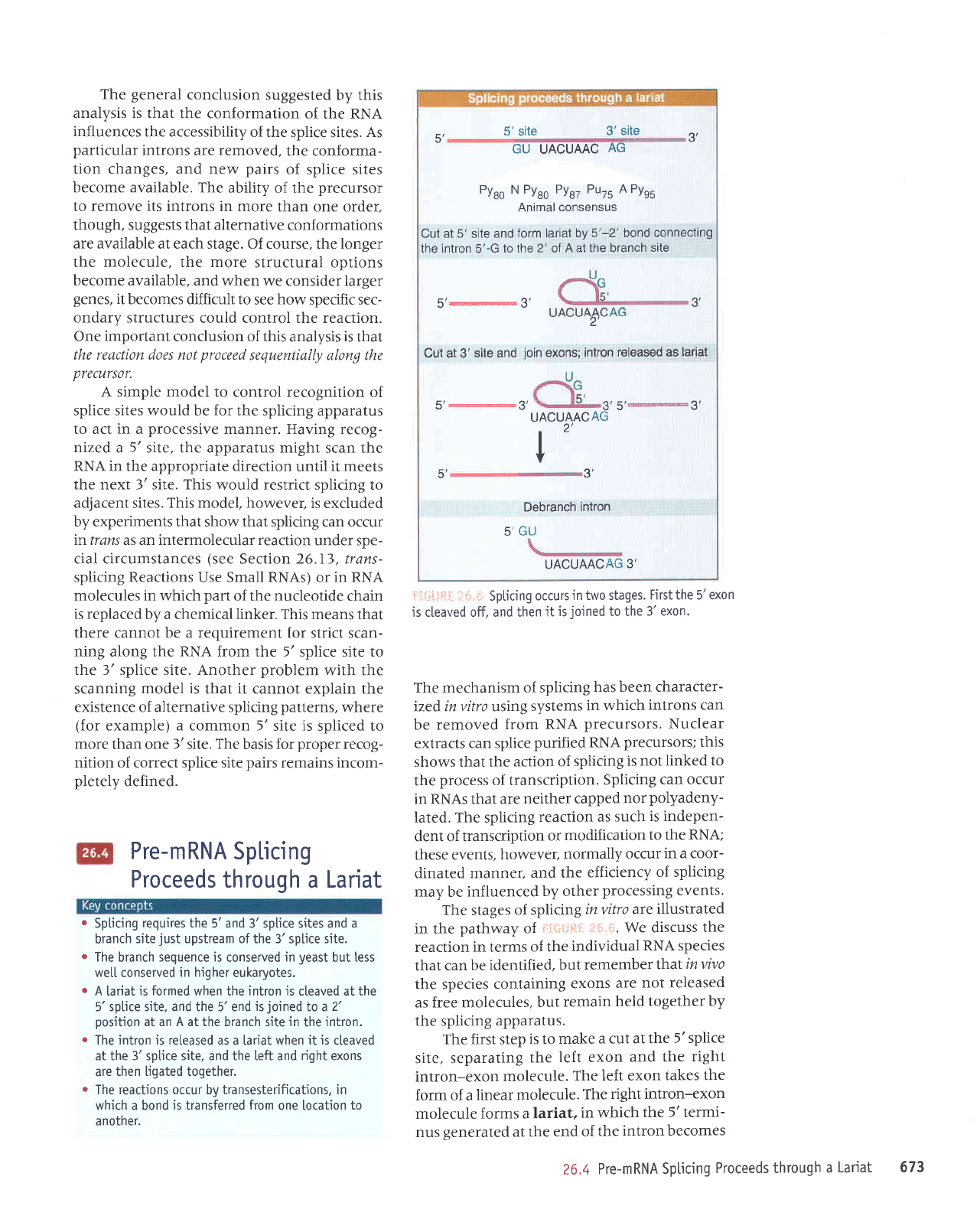
The
general
conclusion
suggested
by this
analysis is that
the conformation
of the RNA
influences
the accessibility
of the
splice sites.
As
particular
introns
are removed,
the conforma-
tion changes, and new
pairs
of splice sites
become available. The
ability
of the
precursor
to remove its introns in
more than one order,
though, suggests that alternative
conformations
are available at each stage. Of course,
the
longer
the molecule, the more
structural options
become available,
and when
we
consider larger
genes,
it
becomes difficult to
see
how
specific sec-
ondary structures
could control the reaction.
One
important
conclusion of this
analysis
is
that
the reaction does not
proceed
sequentially along the
precurs0r.
A simple model to
control recognition of
splice sites
would
be
for
the splicing apparatus
to act in a
processive
manner.
Having recog-
nized
a
5'
site, the apparatus might
scan the
RNA in the appropriate direction
until it meets
the next f'site. This
would restrict splicing to
adjacent
sites.
This model,
however, is excluded
by experiments that show that splicing
can occur
intrans as an intermolecular reaction
under spe-
cial circumstances
(see
Section 26.1), trans-
splicing Reactions Use Small RNAs)
or
in RNA
molecules in which
part
of the nucleotide chain
is replaced by a chemical linker. This means
that
there cannot be a requirement for
strict scan-
ning along the RNA from the 5'
splice site
to
the 3' splice site. Another
problem
with the
scanning
model is
that it cannot explain the
existence of alternative splicing
patterns,
where
(for
example) a common 5'
site
is
spliced to
more
than one
3'site. The
basis for
proper
recog-
nition of correct splice site
pairs
remains incom-
pletely
defined.
Pre-mRNA
Spticing
Proceeds through
a
Lariat
.
Splicing
requires the
5'and 3'splice sites and a
branch
site
just
upstream of the
3' sptice
site.
o
The
branch
sequence is
conserved
in
yeast
but less
wetl conserved
in higher
eukaryotes.
r
A lariat
is formed
when the intron is cteaved at the
5'splice site, and the 5'end
isjoined
to a 2'
oosition
at an A at the branch
site
in
the
intron.
o
The
intron is reteased
as a lariat when
it is
cleaved
at the 3'sptice site, and the left and
right
exons
are
then ligated together.
r
The reactions occur by transesterifications, in
which a bond
is
transferred
from
one location
to
another.
5'
site
3',site
!t
GU
UACUAAC
AG
Pyro N Pyro Pyu,
Puru A Py*
Animal
consensus
Cut at 5' site and
form lariat by
5'-2' bond connecting
the
intron
5'-G
to the 2' of
A at the branch
site
5'@
3/
z
Cut at 3'
site
and
join
exons;
intron
released as
lariat
s'-
3,
3/
5'@
3'
UACUAACAG
t-
I
v
3',
5',
Debranch
intron
5'GU
UACUAACAG
3'
rlii.ilii
i:ii.lr Spticing
occurs
in two stages.
Firstthe 5'exon
is cleaved off. and then
it
is
joined
to the
3' exon.
The mechanism
of splicing
has been character-
ized in vitro using
systems
in which
introns
can
be removed from
RNA
precursors. Nuclear
extracts can
splice
purified RNA
precursors;
this
shows that the
action of
splicing
is not linked
to
the
process
of transcription.
Splicing
can occur
in RNAs
that
are neither
capped
nor
polyadeny-
lated. The splicing
reaction as
such
is indepen-
dent of transcription
or
modification
to the RNA;
these events,
however,
normally
occur
in a coor-
dinated
manner,
and the
efficiency
of splicing
may be
influenced
by other
processing events.
The stages
of splicing
invitro
are
illustrated
in the
pathway
of
i'i{.;lifif
;:ti"i"t. We discuss
the
reaction in terms
of the
individual
RNA species
that can
be identified,
but
rememb
er Ihat
in v:o
the species
containing
exons
are
not released
as free molecules,
but
remain
held together
by
the splicing
apparatus.
The first step
is to
make
a cut at the
5'splice
site, separating
the
left exon
and the
right
intron-exon
molecule.
The
left exon
takes the
form of a
linear molecule.
The
right intron-exon
molecule forms
a lariat,
in which
the 5'termi-
nus
senerated
at the
end of
the intron
becomes
26.4
Pre-mRNA
Spl,icing
Proceeds through
a
Lariat 673
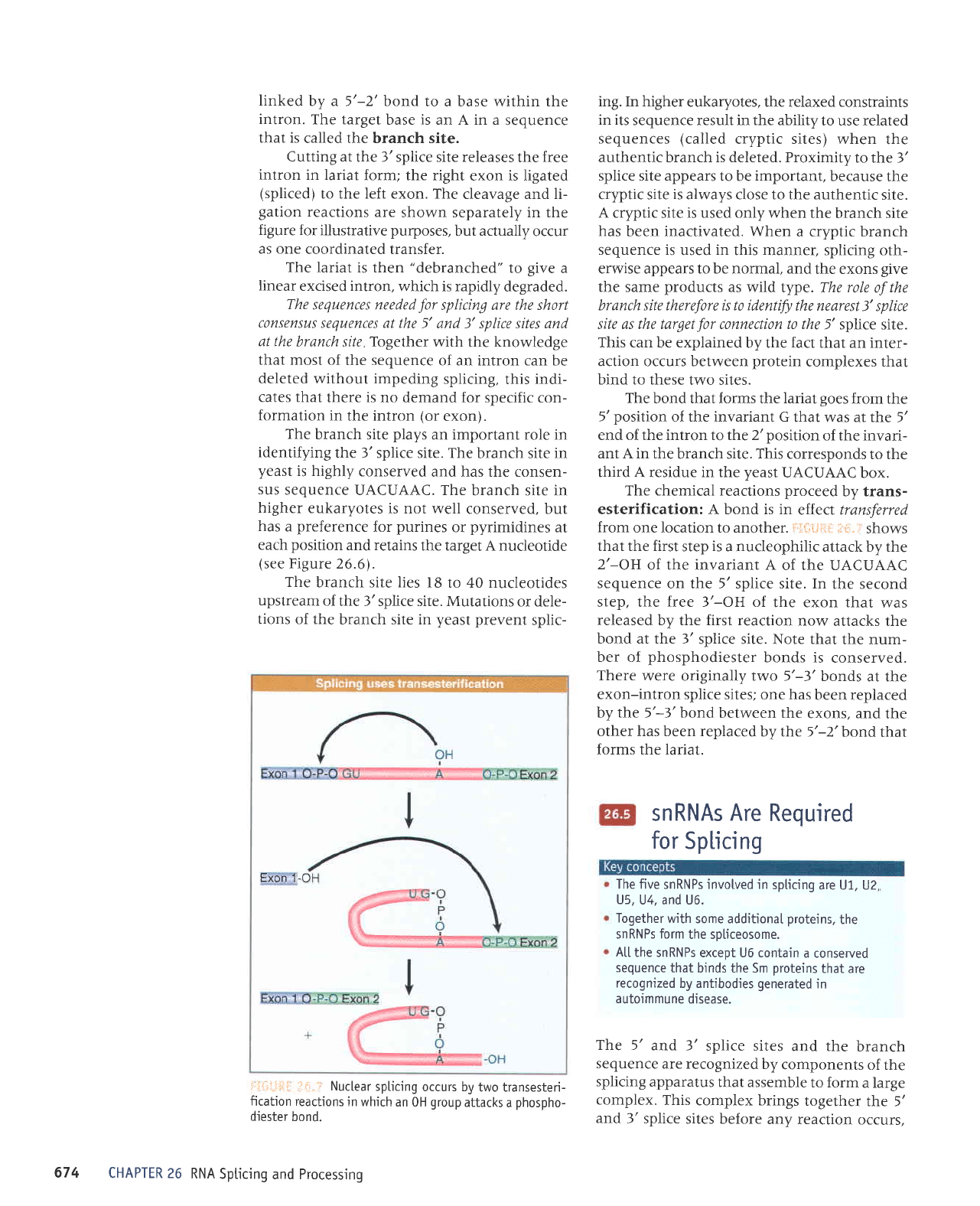
linked
by a 5'-2' bond
to a base within the
intron.
The target
base is an A in a
sequence
that is
called the branch site.
Cutting at
the 3'splice site releases
the
free
intron in lariat
form; the right
exon is ligated
(spliced)
to the left exon. The
cleavage and li-
gation
reactions
are
shown separately in the
figure for
illustrative
purposes,
but actually
occur
as one
coordinated transfer.
The
lariat is then
"debranched"
to
give
a
linear
excised intron,
which is rapidly
degraded.
The
sequences needed
for
splicing are the short
clnsensus
sequences at the
5' and 3' splice sites and
at the
branch
sire
Together
with
the
knowledge
that most
of the sequence
of an intron can be
deleted without impeding
splicing,
this indi-
cates that
there is no demand
for specific con-
formation
in the intron
(or
exon).
The
branch
site
plays
an important role
in
identifying
the 3'splice site. The
branch site in
yeast
is highly
conserved
and has the consen-
sus
sequence
UACUAAC. The
branch site in
higher
eukaryotes
is not
well
conserved, but
has
a
preference
for
purines
or
pyrimidines
at
each
position
and retains
the target A nucleotide
(see
Figure 26.6).
The
branch site lies
l8 to 40 nucleotides
upstream
of
the 3'splice site. Mutations
or dele-
tions of the
branch site in
yeast prevent
splic-
ing. In higher
eukaryotes, the relaxed constraints
in its
sequence result in the ability
to use related
sequences
(called
cryptic sites) when
the
authentic branch is deleted. Proximity
to the 3'
splice site appears
to be
important,
because
the
cryptic site
is
always close to the authentic
site.
A
cryptic site is used only when the
branch site
has
been inactivated. When
a cryptic branch
sequence is
used
in
this manner,
splicing oth-
erwise appears to be normal, and
the exons
give
the same
products
as wild
type. The role
of
the
branch site therefore
is
to identify
the nearest
3' splice
site as the target
for
connection to the
5' splice site.
This can be explained
by the fact that an inter-
action occurs between
protein
complexes that
bind to these
two sites.
The
bond that forms the lariat
goes
from the
5'position
of the invariant G
that was at the
5'
end of the intron to the 2'position
of the invari-
ant A in the
branch site. This corresponds
to the
third A residue in the
yeast
UACUAAC
box.
The chemical reactions
proceed
by trans-
esterification: A bond is in
effect transferred
from
one location to another.
iiiitii..;i':
iti".r
shows
that the first
step
is
a nucleophilic
attack by the
2'-OH
of the invariant A
of the UACUAAC
sequence
on the 5' splice site. In
the second
step, the free J'-OH of
the exon that
was
released
by the first reaction
now
attacks the
bond at the 3'
splice site. Note that
the num-
ber of
phosphodiester
bonds is
conserved.
There
were originally two 5'-3'bonds
at the
exon-intron splice
sites; one has
been replaced
by the 5'-3'bond
between the
exons, and
the
other has been replaced
by the 5'-2'bond
that
forms the lariat.
snRNAs
Are
Required
for
Splicing
The five
snRNPs invotved in
splicing
are U1, U2,
U5,
U4, and U6.
Together
with
some additionaI
proteins,
the
snRNPs form
the soticeosome.
At[
the snRNPs
except U6 contain
a conserved
sequence
that
binds the Sm
proteins
that are
recognized
by antibodies
generated
in
autoimmune
disease.
The 5'
and J'
splice sites
and the
branch
sequence
are recognized
by
components
of the
splicing
apparatus
that assemble
to form
a large
complex.
This
complex brings
together
the 5'
and
3' splice
sites before
any reaction
occurs,
Exon
1-OH
ir
ji.1!i:rii:-
iiti;,
I Nuclear
spl.icing
occurs by
two transesteri-
fication reactions
jn
which an 0H
group
attacks
a
phospho-
diester
bond.
CHAPTER 26
RNA
Spticing
and Processing
674
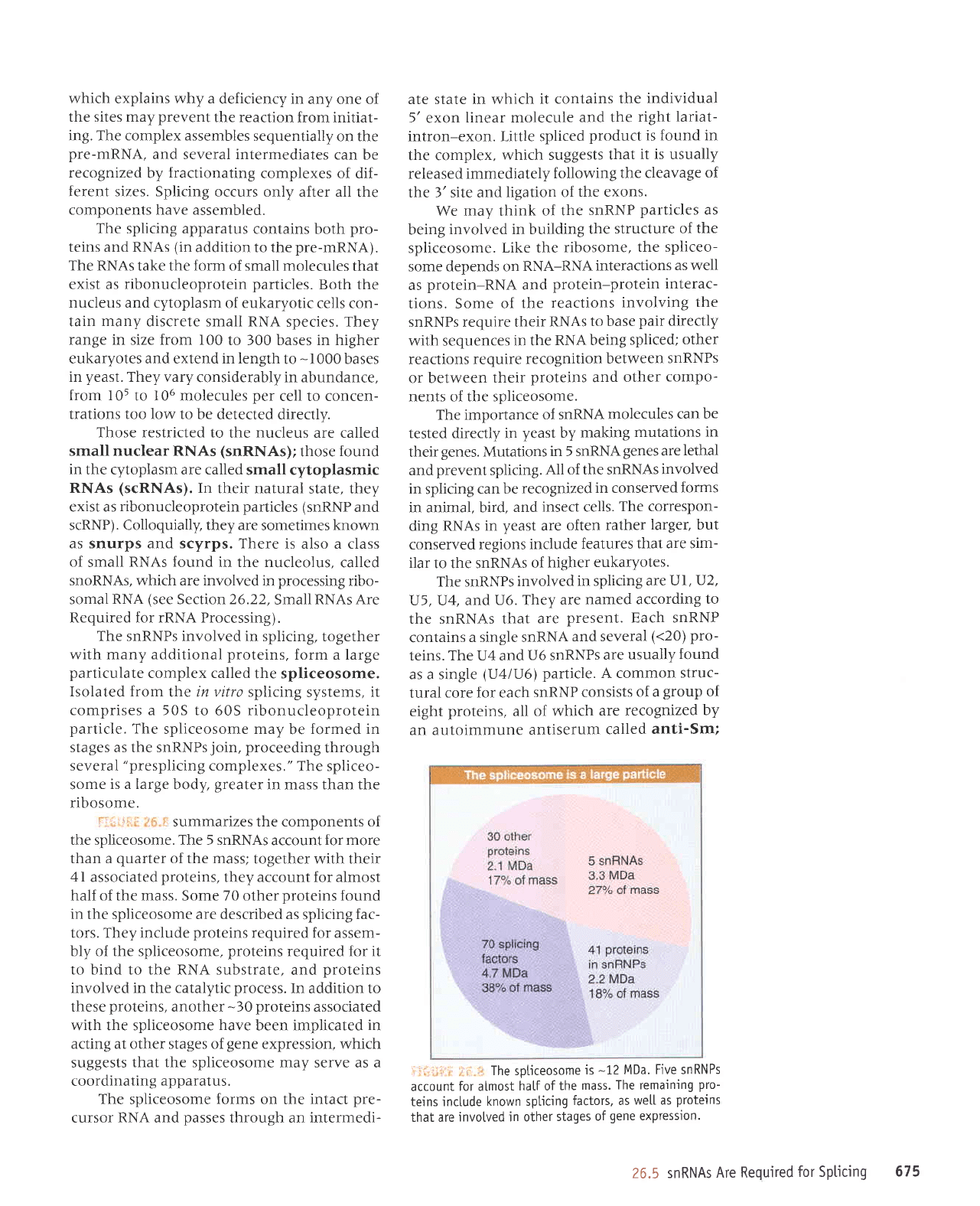
which explains why a
deficiency in
any one of
the sites may
prevent
the reaction
from initiat-
ing. The complex assembles
sequentially
on the
pre-nRNA,
and several intermediates
can be
recognized
by
fractionating
complexes of dif-
ferent sizes. Splicing
occurs only after all
the
components have assembled.
The splicing apparatus
contains both
pro-
teins and RNAs
(in
addition to the
pre-mRNA).
The RNAs
take the form of small
molecules that
exist as ribonucleoprotein
particles.
Both the
nucleus and cytoplasm
of eukaryotic
cells con-
tain
many
discrete small RNA
species. They
range in size from 100
to 300 bases in higher
eukaryotes and extend in length
to
-1000
bases
in
yeast.
They
vary
considerably in abundance,
from 105
to 106 molecules
per
cell to concen-
trations too low to be
detected directly.
Those restricted to
the nucleus are called
small
nuclear RNAs
(snRNAs);
those
found
in
the cytoplasm are called
small cytoplasmic
RNAs
(scRNAs).
In
their natural
state, they
exist as
ribonucleoprotein particles (snRNP
and
scRNP). Colloquially, they are
sometimes
known
as snurps and scyrps. There
is also a class
of small
RNAs found
in the nucleolus,
called
snoRNAs, which are involved
in
processing
ribo-
somal
RNA
(see
Section 26.22,
Small
RNAs
Are
Required for rRNA Processing).
The snRNPs involved
in splicing. together
with many additional
proteins,
form a large
particulate
complex called
the spliceosome.
Isolated from
the in vitro splicing
systems,
it
comprises a 50S to
60S ribonucleoprotein
particle.
The
spliceosome may
be
formed in
stages as the snRNPs
join,
proceeding
through
several
"presplicing
complexes."
The spliceo-
some
is a large
body,
greater
in mass than the
ribosome.
:::.:,rri
,:i
Summarizes the cOmponents of
the spliceosome. The 5 snRNAs
account
for more
than a
quarter
of the mass;
together with their
4l
associated
proteins,
they account for almost
half of the mass. Some 70
other
proteins
found
in the spliceosome are described as
splicing
fac-
tors. They include
proteins
required for
assem-
bly of the spliceosome,
proteins
required for it
to bind to the RNA substrate,
and
proteins
involved in the catalytic
process.
In addition to
these
proteins,
another
-30
proteins
associated
with the spliceosome
have
been implicated
in
acting at other stages of
gene
expression, which
suggests
that the spliceosome
may serve as a
coordinating
apparatus.
The
spliceosome
forms
on the intact
pre-
cursor
RNA
and
passes
through an intermedi-
ate state in which
it contains
the
individual
5'
exon
linear molecule
and the
right lariat-
intron-exon. Little spliced
product is found in
the complex,
which
suggests
that
it is usually
released immediately
following
the cleavage
of
the 3' site and
ligation of
the exons.
We may think
of the
snRNP
particles
as
being
involved in building
the structure
of
the
spliceosome.
Like the
ribosome,
the spliceo-
some depends on
RNA-RNA
interactions
as well
as
protein-RNA
and
protein-protein
interac-
tions. Some of
the
reactions
involving
the
snRNPs require their
RNAs
to base
pair
directly
with sequences
in the
RNA being
spliced;
other
reactions require
recognition
between
snRNPs
or between
their
proteins
and
other
compo-
nents of the spliceosome.
The importance
of snRNA
molecules
can be
tested directly in
yeast
by
making
mutations
in
their
genes.
Mutations
in 5 snRNA
genes
are
lethal
and
prevent
splicing.
All
of the snRNAs
involved
in
splicing can
be recognized
in conserved
forms
in animal, bird,
and
insect cells.
The correspon-
ding RNAs
in
yeast
are
often
rather
larger, but
conserved regions
include
features
that are sim-
ilar
to the snRNAs
of
higher
eukaryotes.
The snRNPs
involved
in splicing
areUl,U2,
\15,lJ4, and
U6. They
are
named according
to
the snRNAs that
are
present. Each snRNP
contains
a single snRNA
and several
(<20) pro-
teins. The U4 and
U6 snRNPs
are
usually
found
as a single
lU4lU6)
particle. A common
struc-
tural
core for each
snRNP
consists
of a
group
of
eight
proteins, all of
which
are recognized
by
an autoimmune
antiserum
called
anti-Sm;
r:i,:r!:il
rlr
r
The spticeosome
is
-12
MDa. Five snRNPs
account
for almost
haLf of
the
mass.
The remaining
pro-
teins inc[ude
known spticing
factors, as
wetl as
proteins
that are
invotved in other
stages
of
gene
expression.
26.5 snRNAs
Are Required
for Spticing
675
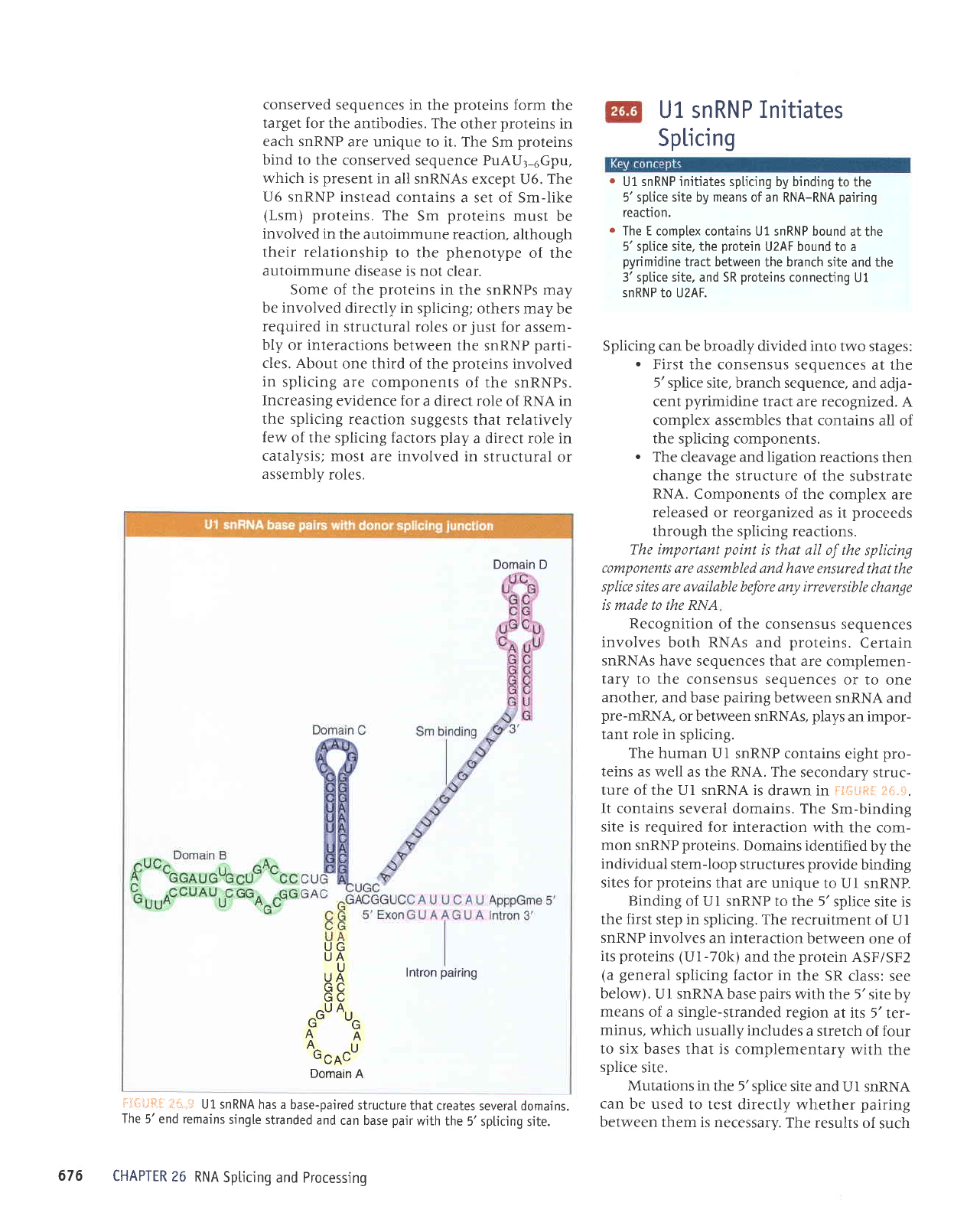
conserved
sequences in the
proteins
form
the
target for
the antibodies. The
other
proteins
in
each snRNP
are unique to it. The
Sm
proteins
bind
to the conserved
sequence PuAU3-6Gpu,
which is present
in
all snRNAs except
U6.
The
U6 snRNP instead
contains
a set of Sm-like
(Lsm)
proteins.
The
Sm
proteins
must
be
involved
in the autoimmune
reaction,
although
their relationship
to the
phenotype
of the
autoimmune
disease is not
clear.
Some of the
proteins
in the
snRNPs
may
be involved
directly in
splicing; others may
be
required
in structural
roles or
just
for
assem-
bly
or interactions
between the
snRNP
parti-
cles.
About
one third of the
proteins
involved
in
splicing
are components
of the snRNPs.
Increasing
evidence for
a direct role
of RNA in
the splicing
reaction
suggests that relatively
few
of the splicing factors play
a direct role in
catalysis;
most
are involved in
structural or
assembly
roles.
U1 snRNP
Initiates
Spl.icing
.
U1 snRNP initiates splicing
by binding to the
5'sptice site
by
means
of an RNA-RNA
pairing
reaction.
o
The E
comptex contains UL snRNP bound
at the
5'splice site, the
protein
U2AF bound to a
pyrimidine
tract between
the branch site and the
3'splice site. and SR
proteins
connecting U1
snRNP to U2AF.
Splicing can be broadly divided into
two stages:
'
First the consensus sequences
at the
5'splice
site, branch sequence, and
adja-
cent
pyrimidine
tract are recognized.
A
complex assembles that contains
all of
the splicing components.
.
The cleavage and ligation
reactions
then
change
the structure of the
substrate
RNA.
Components of the
complex are
released
or
reorganized
as it
proceeds
through the splicing reactions.
The important
point
is that all of the
splicing
components
are assembled and have
ensured that the
splice sites are available before any irreversible
change
is made to the RNA
Recognition of the
consensus sequences
involves
both RNAs and
proteins.
Certain
snRNAs have
sequences that are
complemen-
tary to the
consensus sequences
or to one
another,
and base
pairing
between
snRNA and
pre-mRNA,
or between
snRNAs,
plays
an
impor-
tant role in
splicing.
The human
Ul snRNP contains
eight
pro-
teins as
well as the RNA. The
secondary struc-
ture of the Ui snRNA is
drawn in
ill{itiit*
fii.ll.
It contains
several domains. The
Sm-binding
site is required
for interaction
with the
com-
mon snRNP
proteins.
Domains identified
by the
individual
stem-loop
structures
provide
binding
sites
for
proteins
that are unique
to UI snRNP.
Binding
of Ul
snRNP to the 5'splice
site is
the first step in
splicing. The recruitment
of Ul
snRNP involves
an interaction
between
one of
its
proteins
(Ul
-70k)
and the
protein
ASF/SF2
(a
general
splicing factor in
the
SR class:
see
below)
. U I snRNA
base
pairs
with
the 5' site
by
means
of a single-stranded
region
at its 5'ter-
minus,
which
usually includes
a stretch
of four
to six bases
that is complementary
with the
splice
site.
Mutations
in the 5'splice
site and
UI snRNA
can
be used
to test directly
whether
pairing
between
them is necessary.
The results
of
such
UG
UA
U
UA
88
^U
A,,
G"
,G
4n
A
rl
Gcnc"
Domain
A
Intron
pairing
fliliJ$ll;
;]i:.t
U1 snRNA
has a
base-paired
structure
that creates
severaI domains.
The
5' end remains
sing[e stranded
and
can base
pair
wjth
the 5' spticing
site.
CHAPTER
26
RNA
Spticing
and Processing
Domain D
676
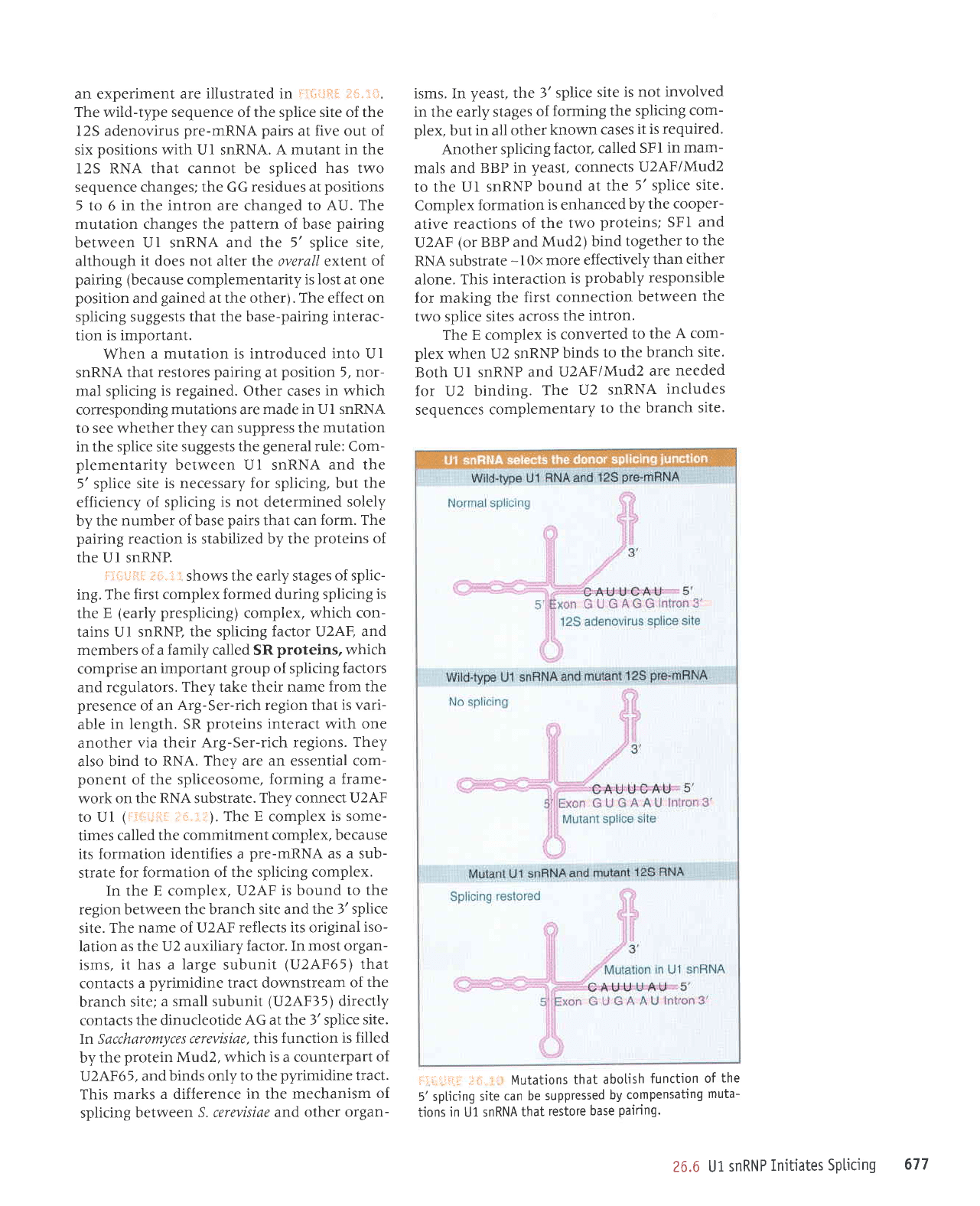
an experiment are
illustrated in
!ri{";i"tqf
iri..1{.i.
The wild-type sequence of the splice site of the
12S adenovirus
pre-nRNA pairs
at five out of
six
positions
with UI snRNA. A mutant
in
the
12S RNA that cannot be spliced
has
two
sequence changes;
the
GG
residues at
positions
5 Lo 6 in the intron are changed to
AU. The
mutation changes the
pattern
of base
pairing
between Ul snRNA and the 5' splice
site,
although
it does not alter the overall extent of
pairing (because
complementarity is lost at one
position
and
gained
at the other). The effect on
splicing suggests
that the base-pairing interac-
tion
is important.
When a
mutation is introduced into UI
snRNA
that restores
pairing
at
position
5, nor-
mal splicing
is regained. Other cases in which
corresponding
mutations are
made in UI snRNA
to see whether
they can suppress the mutation
in the splice site suggests
the
general
rule: Com-
plementarity
between Ul snRNA
and the
5' splice
site is necessary for splicing, but
the
efficiency
of splicing
is not
determined
solely
by the
number of base
pairs
that can
form. The
pairing
reaction is stabilized by the
proteins
of
the Ul snRNP.
iii,r-iiii .,:'.i.ri i
shows the early stages
of splic-
ing. The
first complex formed during splicing
is
the E
(early
presplicing)
complex, which
con-
tains Ul snRNP.
the
splicing
factor U2AF, and
members of a family called SR
proteins,
which
comprise
an important
group
of splicing
factors
and regulators.
They take their name
from the
presence
of an
Arg-Ser-rich region that
is
vari-
able in
length. SR
proteins
interact with
one
another
via their
Arg-Ser-rich regions.
They
also bind
to RNA.
They
are
an essential com-
ponent
of
the spliceosome,
forming a frame-
work
on the
RNA
substrate.
They connect U2AF
to Ul
(iiii:ii:ii:
.:.;.lii).
The E complex
is some-
times called
the commitment complex,
because
its formation
identifies a
pre-nRNA
as a sub-
strate
for formation of
the splicing complex.
In the E complex, U2AF
is bound to
the
region between
the branch site and
the 3'splice
site.
The name of
U2AF reflects its original
iso-
lation
as the U2 auxiliary
factor. In most organ-
isms,
it has a large subunit
(U2AF65)
that
contacts
a
pyrimidine
tract downstream
of
the
branch
site;
a small subunit
(U2AF35)
directly
contacts
the dinucleotide
AG at the l'splice
site.
In Saccharomyces
cerevisiae, this
function is filled
by
the
protein
Mud2, which
is
a counterpart
of
U2AF6r,
andbinds
only to the
pyrimidine
tract.
This marks
a difference
in
the
mechanism
of
splicing
between
S. cerevisiae and
other organ-
isms. In
yeast,
the 3'
splice
site is
not involved
in the early
stages
of
forming
the splicing
com-
plex,
but in all other
known
cases
it is required.
Another splicing
factor,
called
SFI
in mam-
mals and
BBP in
yeast,
connects
U2AF/Mud2
to the
UI snRNP
bound
at
the 5'
splice site.
Complex
formation
is enhanced
by the
cooper-
ative reactions
of the
two
proteins;
SFI
and
U2AF
(or
BBP and
Mud2)
bind
together
to
the
RNA substrate
-l0x
more
effectively
than
either
alone.
This
interaction
is
probably responsible
for making
the
first connection
between
the
two splice sites
across
the
intron.
The E complex
is
converted
to
the
A com-
plex
when U2
snRNP
binds
to
the branch
site.
Both Ul
snRNP
and
U2AF/Mud2
are
needed
f.or lJ2 binding.
The
U2
snRNA
includes
sequences
complementary
to
the branch
site'
;rlliiiiil: :: l,
;
r,,
Mutations
that
abotish
function
of
the
5'spticing
site
can be
suppressed
by compensating
muta-
tions
in U1 snRNA
that
restore
base
pairing.
26.6 U1.
snRNP
Initiates
Spticing
677
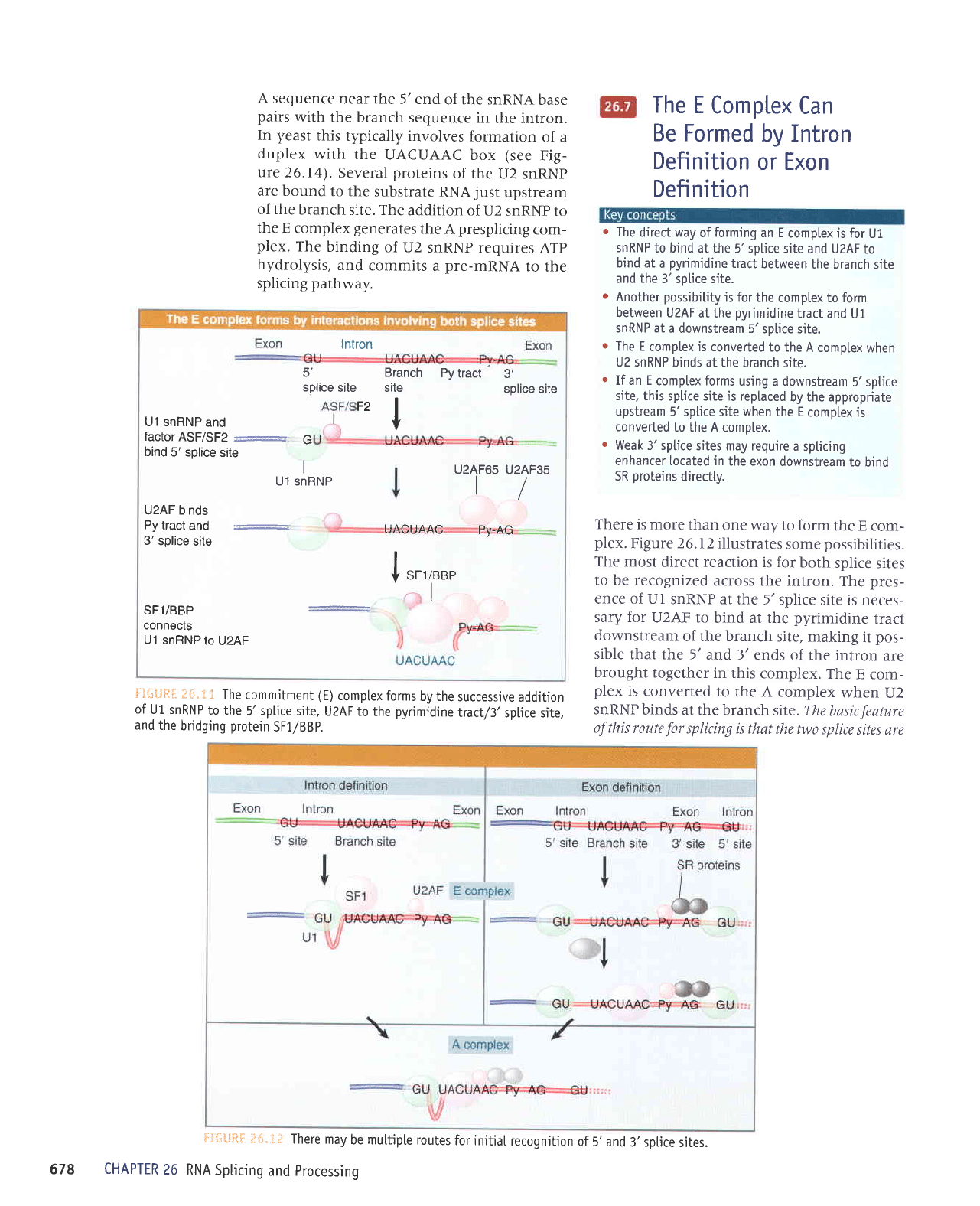
A
sequence
near the
5' end
of the snRNA
base
pairs
with
the
branch sequence
in
the intron.
In
yeast
this
typically involves
formation
of a
duplex
with the
UACUAAC
box
(see
Fig-
ure 26.14).
Several
proteins
of the
U2 snRNP
are bound
to the
substrate
RNA
just
upstream
of the
branch
site. The
addition
of U2
snRNP to
the
E complex generates
the
A
presplicing
com-
plex.
The
binding
of U2
snRNP requires
ATP
hydrolysis,
and
commits
a
pre-nRNA
to
the
splicing
pathway.
Ft{ii1ftil
t*.1 i
The
commitment (E)
comptex
forms
by the
successive
addition
of U1 snRNP
to the
5' splice
site,
U2AF
to the
pyrimidine
tract/3'splice
site,
and
the
bridging
protein
SF1/BBP.
The
E
Complex
Can
Be Formed
Definition
Definition
by Intron
or Exon
r
The
direct way
of
forming
an E
complex is for
U1
snRNP
to bind at
the 5'splice site
and U2AF
to
bind at
a
pyrimidine
tract
between
the branch
site
and the
3'sptice site.
o
Another
possibitity
is for
the
complex to form
between U2AF
at the
pyrimidine
tract
and U1
snRNP at
a downstream 5'sptice
site.
o
The E
complex is converted
to the
A comptex
when
U2 snRNP
binds at the
branch site.
o
If an E
comptex forms
using a downstream
5'spLice
site, this
splice site is reptaced
by the appropriate
upstream
5'sptice site when
the E
comptex is
converted
to the A
comotex.
o
Weak 3'splice
sites may require
a
spticing
enhancer [ocated in
the exon
downstream
to
bind
SR
proteins
directly.
There is more
than
one way
to form
the E com-
plex.
Figure 26.I2
illustrates
some
possibilities.
The most
direct reaction
is for
both
splice
sites
to
be
recognized
across
the intron.
The
pres-
ence of UI
snRNP at
the 5'splice
site is
neces-
sary for
U2AF to
bind at the
pyrimidine
tract
downstream
of the branch
site,
making
it
pos-
sible
that the
5' and 3'
ends of
the intron
are
brought together
in
this complex.
The
E com-
plex
is converted
to
the A complex
when
U2
snRNP
binds at the
branch
site. The
basic
feature
of this
route
for
splicing is that
the two
splice
sites are
Intron
5'
splice
site
Py
tract
3'
splice site
Branch
site
F2 l
U1 snRNP
and
+
factor
ASF/SF2
-:
G
bind
5' splice
site
U1 snRNP
U2AF65 U2AF35
tl
U2AF binds
Py
tract
and :!::
3'
splice
site
SF1/BBP
connects
U1 snRNP
to
U2AF
UACUAAC
Py-AG
|
,.',ru,
ilt#*HL
*{t".tl
There
may
be multipte
routes
for initial"
recognition
of 5'and
3'sptice
sites.
678
CHAPTER
26
RNA
Spticing
and
processing
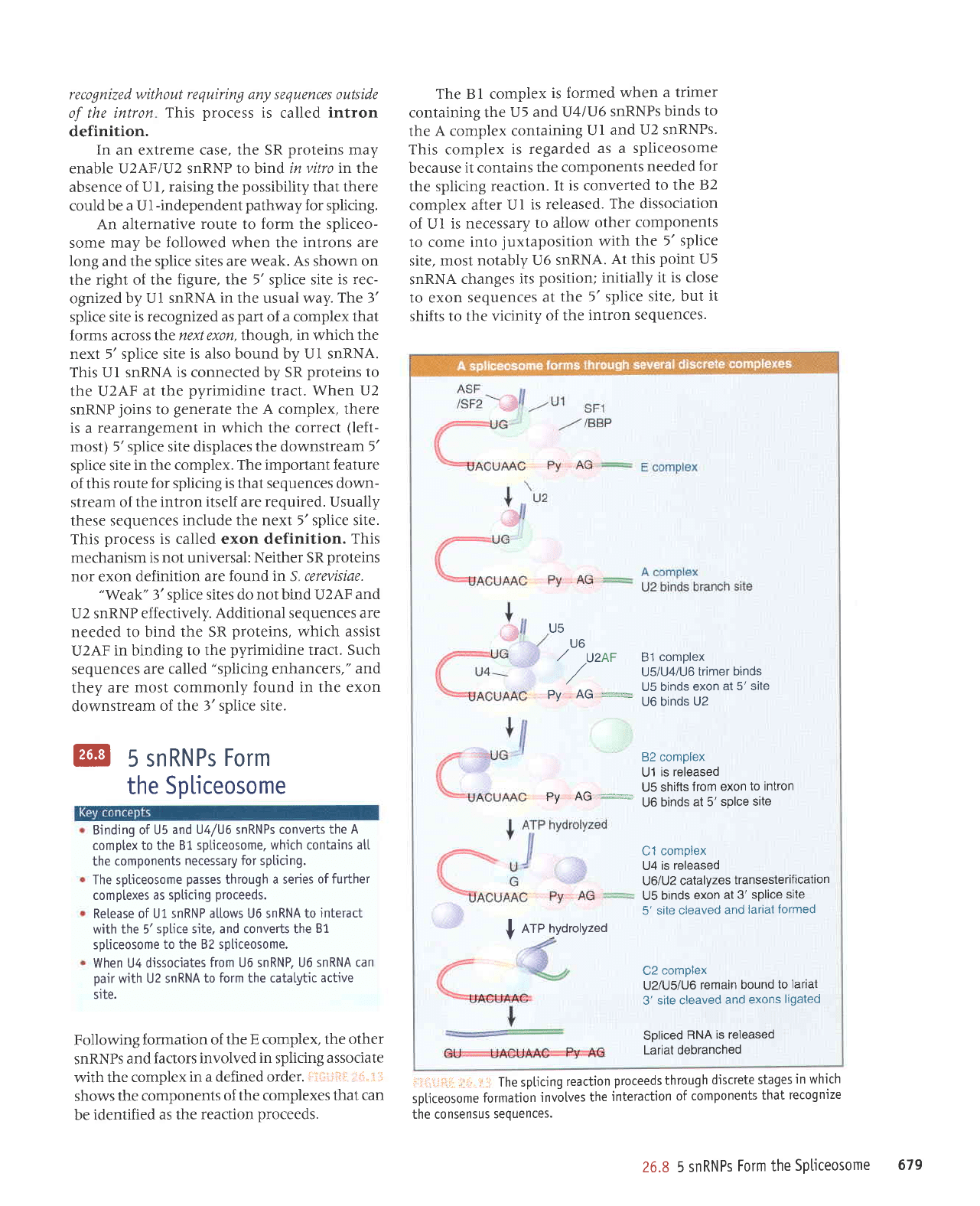
rec7gnized
with1ut requiring any sequences 7utside
of the intron
This
process
is
called
intron
definition.
In
an extreme
case, the SR
proteins
may
enable U2AFlU2 snRNP to bind invitro
in the
absence of
Ul, raising the
possibility
that there
could
be a UI
-independent
pathway
for
splicing.
An alternative
route to form the spliceo-
some
may be followed when the
introns are
long and
the splice sites are
weak.
As shown on
the right of the
figure, rhre 5'
splice
site is rec-
ognized
by Ul snRNA
in
the usual way.
The l'
splice site
is recognized as
part
of a complex that
forms across
rl:,e next exon, though, in which
the
next 5' splice site
is also bound by Ul snRNA.
This Ul snRNA
is
connected by SR
proteins
to
the U2AF
at the
pyrimidine
tract.
When U2
snRNP
joins
to
generate
the A complex, there
is a
rearrangement in which the correct
(left-
most) 5'splice site displaces
the downstream
5'
splice site
in the complex.
The important feature
of this
route for splicing
is
that sequences
down-
stream of
the intron itself are required.
Usually
these
sequences
include the next 5'splice site.
This
process
is called exon definition.
This
mechanism
is not universal: Neither SR
proteins
nor exon definition
are found in S. cerevisiae.
"Weak"
3'splice
sites do notbind U2AF
and
U2 snRNP
effectively.
Additional sequences are
needed to bind
the SR
proteins,
which
assist
U2AF
in binding to the
pyrimidine
tract. Such
sequences
are
called
"splicing
enhancers,"
and
they
are most commonly
found in the exon
downstream
of the
3'splice site.
The B I complex
is formed
when a trimer
containing the
U5 andIJ4ltJ6
snRNPs
binds
to
the
A complex containing
UI
and U2
snRNPs.
This
complex
is regarded
as a spliceosome
because
it
contains
the components
needed
for
the
splicing
reaction.
It is converted
to the
82
complex after
Ul
is released.
The dissociation
of Ul
is necessary
to allow
other
components
to come
into
juxtaposition
with
the
5' splice
site, most
notably U6
snRNA.
At this
point
U5
snRNA
changes
its
position; initially
it
is close
to exon
sequences
at
the 5'
splice
site, but
it
shifts to the
vicinity
of the
intron
sequences.
i ii.t'rjiiii
,r
r...i
1
The spticing
reaction
proceeds
through
discrete
stages
in which
sotjceosome
formation
invotves
the
interaction
of components
that
recognize
the consensus
sequences.
@ 5 snRNPs
Form
Binding of U5
and U4/U6 snRNPs converts
the A
comptex to the
B1 spliceosome. which contains
atl
the
components
necessary for spticing.
The spticeosome
passes
through a series
of further
comptexes
as spticing
proceeds.
Release of U1
snRNP atlows U6 snRNA to
interact
with the 5'splice
sjte, and converts the
81
spliceosome
to the B2 spliceosome.
When
U4 dissociates
from U6 snRNP, U6
snRNA can
pair
with U2 snRNA
to form the catatytic
active
site.
Following
formation of
the E complex, the
other
snRNPs
and
factors involved
in
splicing
associate
with the
complex
in a defined order.
i:i'iri"iiif f
ii.:r
i-t
shows
the components
of the complexes
that can
be identified
as the
reaction
proceeds.
the
SpLiceosome
U5
U6
,/
)J2AF
Bl
complex
/
USlUAluB
trimer binds
U5 binds
exon
at 5' site
t'Y
Au
:-:
U6 binds U2
82 comPlex
U1
is released
U5 shifts
irom
exon
to intron
vY
Au
-'-
U6
binds
at 5' splce
site
C1
complex
U4
is released
U6lU2
cataly
zes transesterif
ication
U5
binds exon
at
3' sPlice
site
5' site
cleaved
and
lariat
formed
C2
complex
UZ|US|UG
remain
bound
to
lariat
3'
site cleaved
and
exons
ligated
Spliced
RNA
is released
Lariat debranched
I
nre hydrolyzed
26.8 5
snRNPs
Form the
SPticeosome
679
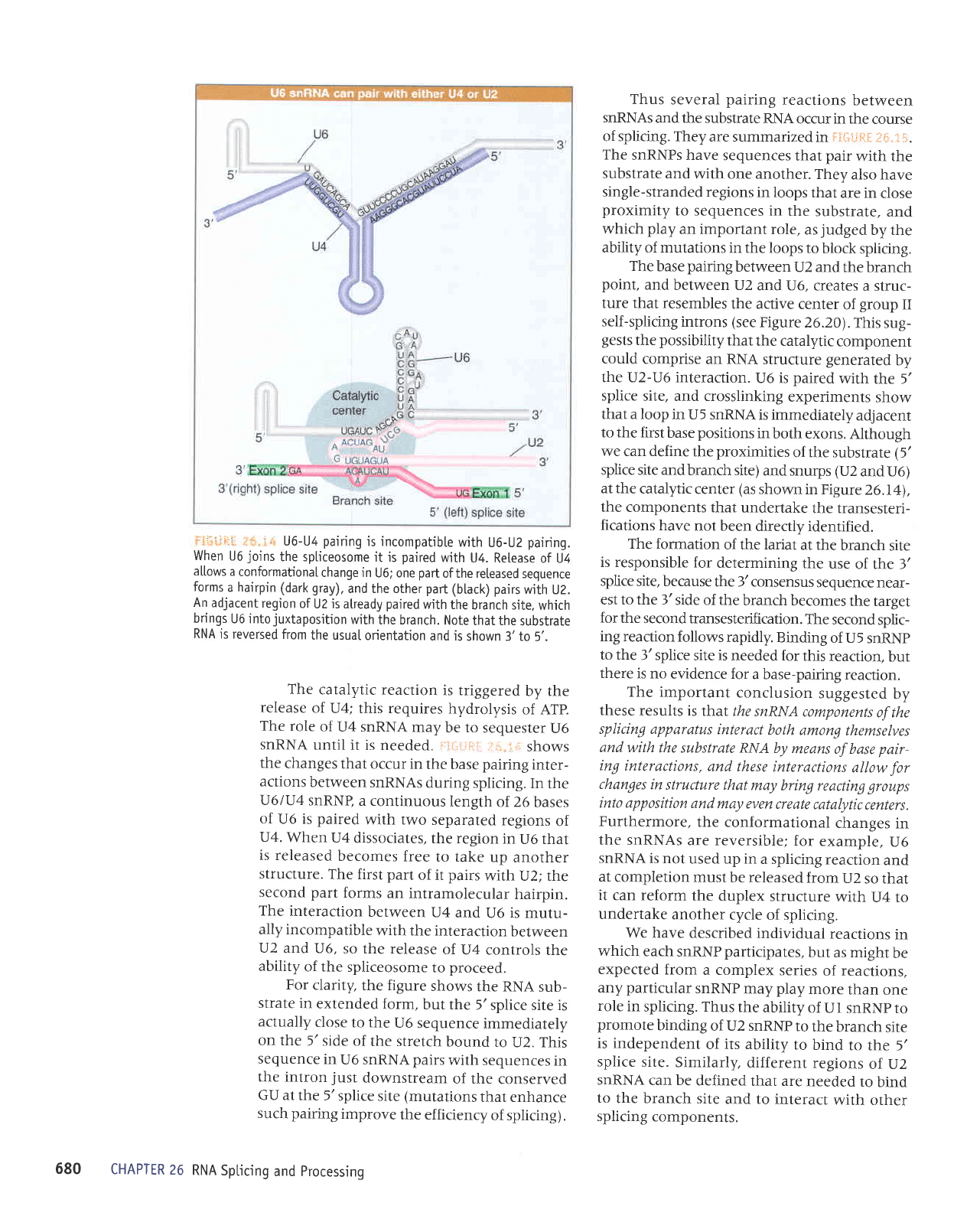
'
::'
'
U6-U4
pairing
is incompatibte
with
U6-U2
pairing.
When
U6
joins
the spticeosome
it is
paired
wjth
U4. Retease
of U4
a[[ows
a
conformationaI
change in
U6; one
part
ofthe reteased
sequence
forms
a
hairpin (dark
gray).
and the other
part
(btack) pairs
with
U2.
An
adjacent
region
of
U2 is atready
paired
with the
branch site,
which
brings
U6 into
juxtaposition
with
the branch.
Note
that the
substrate
RNA
is reversed
from
the usuaI
orientation
and is
shown 3'to
5'.
The
catalytic
reaction
is triggered
by the
release
of
U4; this requires
hydrolysis
of ATp.
The role
of
U4 snRNA
may
be to
sequester
U6
snRNA
until
it is needed. i:i;i"iiil,
,:r+
:*
shows
the
changes
that
occur in
the base
pairing
inter-
actions
between
snRNAs
during
splicing.
In
the
U6lU4
snRNP,
a continuous
length
of 26
bases
of
U6 is
paired
with two
separated
regions
of
U4.
When
U4
dissociates,
the region
in
U6 that
is released
becomes
free
to take
up
another
structure.
The first
part
of it
pairs
with
U2; the
second part
forms
an
intramolecular
hairpin.
The
interaction
between
U4
and
U6 is mutu-
ally incompatible
with the interaction
between
U2 and
U6,
so the
release
of
U4 controls
the
ability
of the
spliceosome
to
proceed.
For
clarity,
the figure
shows
the RNA
sub-
strate
in
extended
form,
but the
5'splice
site is
actually
close
to the
U6
sequence
immediately
on the
5' side
of
the srretch
bound
ro
U2. This
sequence
in
U6 snRNA pairs
with
sequences
in
the intron
just
downstream
of the
conserved
GU at
the 5'splice
site
(mutations
that enhance
such pairing
improve
the efficiency
of splicing).
CHAPTER
26
RNA
Spl.icing
and Processing
Thus
several
pairing
reactions
between
snRNAs
and the substrate
RNA
occur in the
course
of splicing. They
are summarized
in f3{rltSii
t{i-i5.
The
snRNPs have
sequences
that
pair
with the
substrate and
with one another.
They
also have
single-stranded regions
in loops
that
are in
close
proximity
to sequences in
the
substrate,
and
which
play
an important
role,
as
judged
by the
ability of mutations
in the loops
to
block
splicing.
The
base
pairing
between
U2 and
the branch
point,
and
between U2
and U6,
creates
a struc-
ture that resembles
the active
center
of
group
II
self
-splicing
introns
(
see Figure
2 6.20)
. This
sug-
gests
the
possibility
that
the catalytic
component
could
comprise
an RNA structure generated
by
the U2-U6 interaction.
U6 is
paired
with
the 5'
splice
site, and crosslinking
experiments
show
that a loop
in U5
snRNA is immediately
adjacent
to the first
base
positions
in
both exons.
Although
we can define
the
proximities
of the substrate (5'
splice site and
branch site)
and snurps (U2
and U6)
at the
catalytic
center
(as
shown
in Figure
26.14\
,
the components
that
undertake
the transesteri-
fications
have
not been
directly
identified.
The formation
of the lariat
at the
branch
site
is responsible
for
determining
the
use
of the 3'
splice
site, because
the 3'consensus
sequence near-
est to the 3'side
of the
branch
becomes
the target
for
the
second transesterification.
The
second
splic-
ing reaction
follows
rapidly.
Binding
of U5
snRNp
to the
3'splice
site
is
needed
{or this
reaction,
but
there
is no
evidence for
a base-pairing
reaction.
The
important
conclusion
suggested
by
these
results is
that the
snRNA
components
of the
splicing apparatus
interact
both
among
themselves
and with
the substrate
RNA by
means
of base
pair-
ing interactions,
and these
interactions
allow
for
changes
in
structure that
may
bring reacting grlups
into apposition
and
may even
create
catalytic
centers.
Furthermore,
the
conformational
changes
in
the
snRNAs
are reversible;
for
example,
U6
snRNA
is not
used up in
a splicing
reaction
and
at
completion
must
be released
from
U2
so that
it can reform
the duplex
structure
with
U4 to
undertake
another
cycle
of splicing.
We have
described
individual
reactions
in
which
each
snRNP
participates,
but
as might
be
expected
from
a complex
series
of reactions,
any
particular
snRNP
may
play
more
than
one
role
in
splicing. Thus
the
ability
of
Ul snRNp
to
promote
binding
of U2 snRNP
to
the
branch
site
is independent
of its ability
to
bind
ro
the 5'
splice
site.
Similarly,
different
regions
of U2
snRNA
can be
defined
that are
needed
to
bind
to
the branch
site
and to
interact
with other
splicing
components.
680
